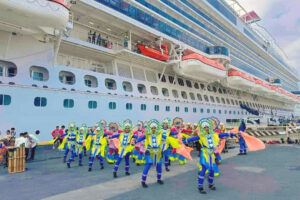THE quality of port and terminal infrastructure is the main challenge to Philippine plans to become a major cruise destination, a tourism official said.
“Unfortunately, one of our biggest challenges is infrastructure. We don’t have world class and globally competitive cruise ports and cruise terminals,” Paulo Benito S. Tugbang, director for product and market development at the Department of Tourism (DoT), told BusinessWorld on the sidelines of the welcome reception for the Seatrade Cruise Asia convention.
Asked about Philippine companies in the cruise industry, he said there are none, though the government is “not closing its doors” should any domestic company plan to invest.
Seatrade Cruise Asia, which seeks to promote the potential of Asia as a destination and market for cruise tourism, brings together cruise industry delegates, itinerary planners, port agents, excursion handlers, and cruise associations.
In a statement, the DoT said the government will simplify the visa application process for visa-required nationals on board cruise ships.
Mr. Tugbang said one of the advantages of the Philippines is that it offers multiple destinations.
President Ferdinand R. Marcos, Jr. said the Philippines is seeking to “play a constructive role in this evolving industry.”
“We are focused on strengthening infrastructure, forging meaningful partnerships, and ensuring that both the cruise industry and local communities will flourish,” he said in a speech at the welcome reception.
On the sidelines of the conference, Tourism Secretary Ma. Esperanza Christina G. Frasco said described the Philippine cruise tourism portfolio as “very promising.”
“We received 125 port calls in 2023 and over 100 this year. And our destinations and islands are increasing from 30 plus to a little over 40 now,” Ms. Frasco told reporters.
In 2022, the DoT submitted a list to the Department of Transportation (DoTr) of the ports and airports that need to be improved to serve the cruise industry.
“We are pleased with the announcements made by the DoTr and the Philippine Ports Authority that new ports are being built in Siargao and Boracay, which will specifically be for cruising. Other ports are also being improved all over the country,” she said.
“As far as Metro Manila is concerned, we are working closely with the City of Manila, as well as those that administer the South Harbor, because what we want is a positive experience for our tourists,” she added.
“The challenge for us is that we do not govern these ports, but we are grateful that they have been very open to our suggestions,” she said.
She said that the DoT sees cruise tourism as a platform for raising the profile of Philippine food, cultural traditions, and artisans.
“That is the focus now of the DoT — to reintroduce the Philippines to the world on the strength of our culture, and we believe that cruise tourism will help us do just that,” she added.
As of Oct. 31, the Philippines welcomed 4.88 million foreign visitors, equivalent to 63.4% of the department’s target of 7.7 million. — Kyle Aristophere T. Atienza, Justine Irish D. Tabile
